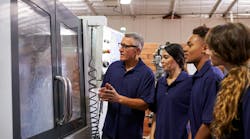“There is no reason and no way that a human mind can keep up with an artificial intelligence machine by 2035,” predicted the techno-futurist philosopher, Gray Scott. Here, Claudia Jarrett, country manager at obsolete parts supplier EU Automation, explains how, through automation, manufacturers can greatly enhance their processes—and address the US’s continued labor skills shortage.
Another keen futurist, Elon Musk, observed that “The pace of progress in artificial intelligence (AI) is incredibly fast. The risk of something seriously dangerous happening is in the five-year timeframe, 10 years at most.” He and Scott’s comments are extreme examples of the old fear that machines will one day conquer humans—and both make their predictions within very short timeframes.
Meanwhile, recent world events have placed a new perspective on the role of automation and robots in the industry. They include the ongoing COVID-19 pandemic and the unprecedented skilled labor shortage in the US. According to US government data and ThomasNet, 30% of manufacturers say they are currently seeking new hires during the COVID-19 pandemic. Yet, the overall employment rate in manufacturing has declined sharply by 19.1% from January to April 2020. Manufacturers are struggling to hire new people—but what can they do about it?
The recent COVID-19: What it means for industrial manufacturing report by Pricewaterhouse Coopers (PwC) advised that manufacturers should increase their use of automation to reduce the number of workers on the factory floor.
It seems that companies are doing just that. Fifty percent surveyed
These data-driven technologies might create the impression that Industry 4.0 requires significant capital investment from businesses. Actually, that does not need to be the case. Instead, the key may lie in applying the latest specialist technologies, like sensors, as part of a low-cost digital retrofitting strategy. This is where an industrial automation parts supplier, like EU Automation, can help.
One thing’s for sure, sourcing the right automation parts will be crucial to creating safer, automated environments—perhaps even go some way to addressing the labor skills gap. Whether or not, to paraphrase Gray Scott, a human mind can keep up with an artificial intelligence machine by 2035, the opportunities for growth and collaboration could prove fascinating.











